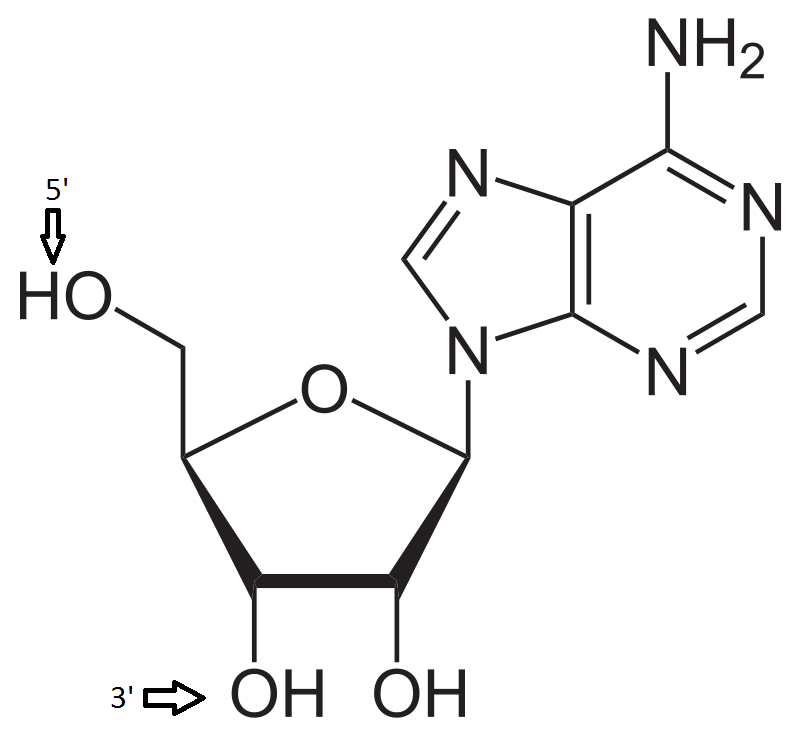What is DNA?
DNA stands for Deoxyribo Nucleic Acid, and it is the cell's primary means of storing information. DNA is a polymer, composed of four nucleotide building blocks, adenosine, guanosine, thymidine and cytosine in DNA these nucleotides are in their monophosphate form. The order of these building blocks in the polymer are used to store information. Each of these bases can form a pair with another, adenosine bonds to thymidine, and guanosine bonds to Cytosine. DNA molecules are composed of two complementary strands, which means that for every adenosine in one strand there is a complementary thymidine bound to it from the opposite strand.
DNA is directional
What that means is that like text DNA is read in a particular order. Take Adenosine for instance:

It has two ends a 5' end which contains a phosphate group (PO4) and a 3' end which has an OH. In the DNA single strand polymer, the 5' PO4 forms a covalent bond with the 3'OH of the previous nucleotide. DNA is read from the 5' end to the 3' end in groups of three bases. These groupings are called codons. Codons are identified by special RNA (Ribo Nucleic Acid) molecules called tRNAs. tRNAs have the important job of translating (hence the t in tRNA) the nucleic acid sequence into a protein with the help of a specialized cellular machine called the ribosome (which I will leave for another day).
Each three base codon corresponds to a specific amino acid residue (amino acids are the building blocks of a protein, just as nucleotides are the building blocks of DNA. You will notice that there are oftentimes several different codon groupings which can be translated into the same protein (good eye). This is important for cells, as it is a mechanism by which mutations (changes to the DNA code) can accumulate in the DNA but not have any downstream effect on the protein machinery that DNA serves as the blueprint for. ( I will go more into mutations in the future as well).
The Entirety of a Cells DNA is Called its Genome
The genome is all of a cells genetic code, every cell in a higher organism (such as you) has the exact same (more or less, not accounting for small mutations which have arisen) genome. This means every cell in your body, has all of the instructions for the creation of every protein, and also the instructions necessary to be every single other cell in your body. How is this possible you might wonder, cells from my eye are nothing like cells from my brain, or toe or liver or heart! This is very true, but each of those cells all have a full copy of your genome! They all have the very same one. The mechanism by which they become what they are is through regulation of what parts of that genome are used to make what proteins! (which is yet another topic for a different day)
Every Time a Cell Divides, its Entire Genome is Copied
For a rapidly dividing human cell, it will divide from one cell into two every 24 hours. The total length of the human genome is over 3 billion base pairs in length. These three billion basepairs need to be copied exactly, in that 24 hour period. This means that the DNA replication is occurring at a rate of ~ 34722 bases linked together per second per strand! This process is performed by specialized enzymes called DNA polymerases, who's job is to catalyze the chemistry necessary to link that 5' Phosphate I mentioned before to the 3' OH of a previous nucleotide. ( I will go more into DNA replication in a subsequent post as well )
Part 1 Wrap Up
DNA is the storage molecule for all of the information necessary to produce every aspect of your body, it does this through a code of triad basepair sequences which are converted into proteins by the ribosome. At its fastest the entirety of the human genome must be replicated in a minimum of 24 hours, which means a nucleotide is being joined to another one at a minimum of 35 thousand times per second, in each rapidly dividing cell in your body. For reference there are currently estimated to be 30000000000000 cells in the human body, which makes the amount of replication going on in each one of us absolutely staggering.
Part 2 to follow!
